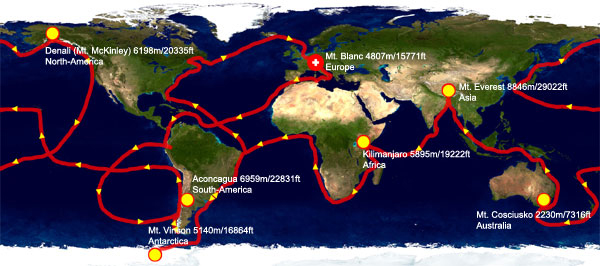This year, more than a thousand people will try to climb Denali. Some of those will be making the attempt as part of a “seven summits” expedition, which involves reaching the highest point on all seven continents. One family expedition, named Top to Top, is attempting the seven summits in a way that has never been done before.
For most climbers coming to Denali from outside of Alaska, the trip involves long hours of travel via planes and road vehicles. For Dario and Sabine Schwörer and their children, it meant years of travel by very different means, as Dario explains.
“Just sail from one continent to the other, and then climb the highest peak in each of the seven continents…Denali was actually our second-last.”
To get to Denali, the Schwörer family sailed through the Panama Canal and up the coast to Whittier before cycling their way to Cordova and spending the winter there. In the spring, they began the trip north to Talkeetna, where local climbing experts Willi Prittie, Brian Okonek, and Roger Robinson provided insight on the terrain and the best way to get in and out of the Alaska Range without an engine. Dario says the feeling of true wilderness on the way in and out is part of what appeals to him.
“It was a little bit [of] an adventure to get through the willows on the moraine to get to the Kahiltna Glacier, and then it was straight forward. It was so nice, no people, this wonderful mountain surrounding you…”
Once the expedition reached base camp, they begin seeing other people again, and on the way down, there were hundreds of climbers on the mountain. Martin Schuster grew up in Alaska and was part of the Denali climb. He also says that the parts of the trip that were off the beaten path were the most memorable.
“From Petersville up to base camp and from base camp down to Talkeetna, we didn’t see anybody. That really made the trip for me. It was really cool just being out in the middle of nowhere without one hundred, two hundred people doing the exact same thing you are.”
The Denali climb was successful, but for Dario and Sabine, that’s not the most important part of the expedition.
“In Top to Top, on this global climate expedition, we really try to volunteer as much as possible for a good cause and then teach the children and inspire them with all the positive examples we encounter on our journey. That’s actually really filling our batteries.”
Sabine Schwörer did not climb Denali, since the family’s children are too young for the harsh environment. Instead, she stayed behind and conducted homeschooling and other aspects of the expedition. She has been part of the expedition since the first day, back in 2002. She jokes that Dario told her it would only take four years to finish the journey. Twelve years and four children later, she says she is still enjoying the trip.
“I really, really enjoy the time in the classrooms, and working with the children, and how amazing [the] ideas they have [about] what we could do better with our planet. I think it’s really important to invest in the children. They are so open, and they still have lots of the future in their hands.”
In all, the Top to Top expedition has sailed more than 70,000 nautical miles, and Dario and Sabine have shared their journey with more than 70,000 students in a hundred countries. Their work in local initiatives has helped clean up more than 50,000 tons of waste. They have one continent and one peak left to do, Mount Vinson in Antarctica. They aren’t in any particular hurry to get there, though.
“Our idea is to go through the Northwest Passage, so we go again out to the Aleutians and up to Cape Barrow, then through the Arctic to Greenland, then make it down the East Coast of the U.S., through Panama, then to Patagonia again and Antarctica. So what we’re trying to do is a figure-eight around the two Americas.”
Obviously, that route takes much longer then sailing straight back down the West Coast of North and South America. Dario estimates another three or four years ought to do it. No doubt thousands more children will share in the Schwörer family’s one-of-a-kind journey by the time it’s over.





